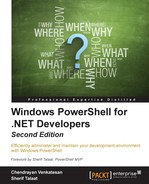Debugging in PowerShell is similar to that in other programming languages. Script debugging is available in the console host as well as in the PowerShell ISE; ISE has both GUI and cmdlet-based debugging, whereas console has only cmdlets to debug your scripts.
The debugging feature in the PowerShell ISE is available under the Debug tab, which is self-explanatory. Let's take a look at the breakpoints and debug cmdlets:
(Get-Command -Name *Debug*).Where({$_.Source -ne 'Azure' -and $_.CommandType -eq 'cmdlet'}) Get-Command -Name *BreakPoint
Note that in the first snippet, I used the where method to ignore Azure and to get only the core cmdlets; the output is illustrated in the following image:

Windows PowerShell has three types of breakpoints. They are as follows:
In this, the script pauses when the designated line is reached during the operation of the script. For example, run the following command:
$line = Set-psbreakpoint -script C:TempScriptdemo.ps1 -Line 4 $line | fl
The output is as follows:
Id : 6 Script : C:TempScriptdemo.ps1 Line : 4 Column : 0 Enabled : True HitCount : 0 Action :

In this, the script pauses whenever the designated variable's value changes. Run the following command:
$Variable = Set-psbreakpoint -script C:TempScriptdemo.ps1 -Variable Server $Variable
In this, the script pauses whenever the designated command is about to be run during the operation of the script. It can include parameters to further filter the breakpoint to only the operation that you want. The command can also be a function that you create. Run the following command:
$cmd = Set-PSBreakpoint -Command Get-Service $cmd | Enable-PSBreakpoint
The output is illustrated in the following image:

The Disable-PSBreakpoint cmdlet disables the breakpoint temporarily, whereas the Remove-PSBreakpoint cmdlet removes the breakpoint permanently.
After setting up the required breakpoints, we can debug the scripts by simply executing the PS1 file. In this example, we have enabled only the variable breakpoint. Take a look at the following image:

The points marked in the figure are explained in the following list:
- 1: Here, the variable breakpoint is hit for
$server. We see it twice because$serveris used in two places. To step over use the short cut key S. - 2: Now, we are in debug mode.
When we do step over, the script in ISE looks like the following image:

In Windows PowerShell 5.0, Wait-Debugger and Debug-Job are the two new debugging cmdlets.
Debug-Job: This debugs a running background, remote machine, or Windows PowerShell Workflow jobWait-Debugger: This stops a script in the debugger before running the next statement in the script, as shown in the following image:
In the following example, we have used the Set-PSBreakPoint cmdlet instead of the Wait-Debugger cmdlet:
$job = Start-Job -ScriptBlock { Set-PSBreakpoint C:TempScriptdemo.ps1 -Line 4; C:TempScriptdemo.ps1 } $job

In the figure we can see that the state is AtBreakpoint.
The following cmdlet will enter debug mode of the running job:
Debug-Job $job -Verbose
Windows PowerShell 5.0 makes it easy for us to debug the PowerShell scripts. Using the Set-PSBreakPoint cmdlet, we can pause the execution of the script at a particular line before we proceed further. Just to avoid the risk! Debugging is easy in Windows PowerShell!
